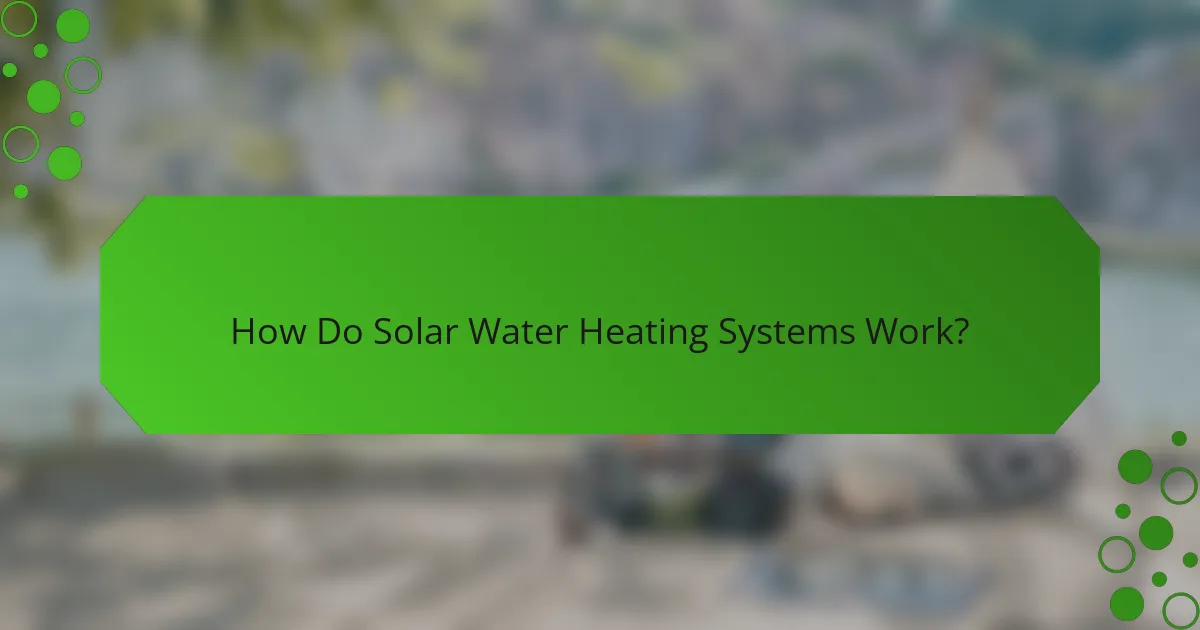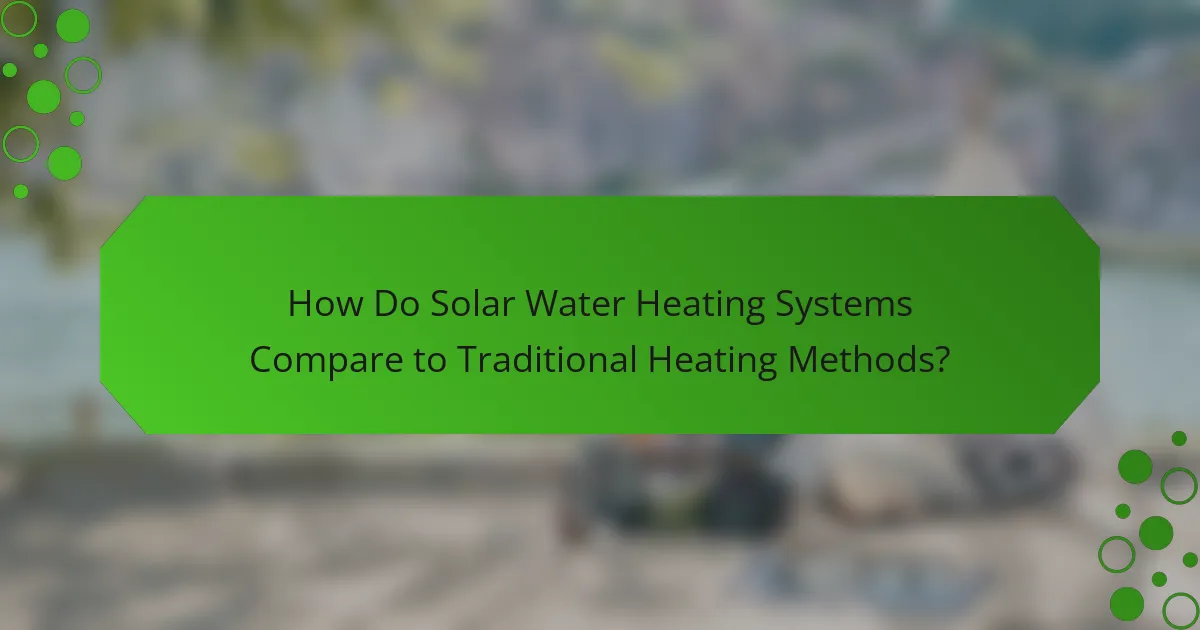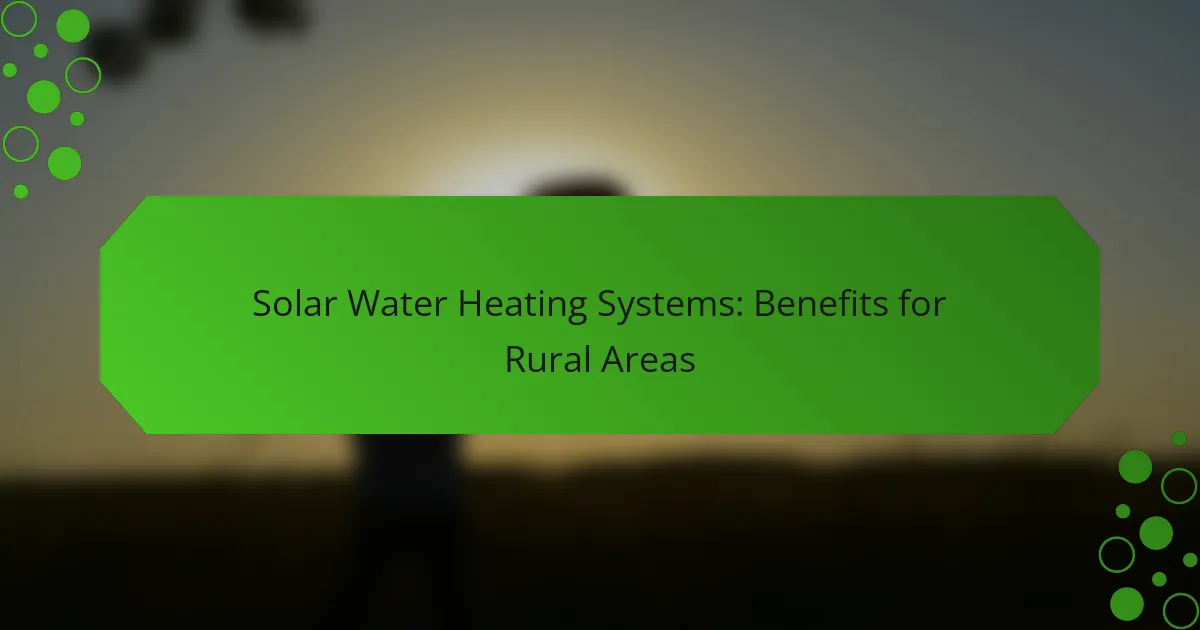Solar water heating systems present a valuable opportunity for rural areas by reducing energy costs and promoting environmental sustainability. By utilizing sunlight to heat water, these systems not only meet residential and agricultural demands but also enhance self-sufficiency in energy use. With both active and passive options available, they can be tailored to fit diverse needs and conditions in rural communities.

What Are the Benefits of Solar Water Heating Systems for Rural Areas?
Solar water heating systems offer significant advantages for rural areas, including lower energy costs, environmental benefits, and enhanced self-sufficiency. These systems harness sunlight to heat water, providing a sustainable solution for residential and agricultural needs.
Cost savings on energy bills
Implementing solar water heating can lead to substantial cost savings on energy bills. By utilizing free solar energy, households can reduce their reliance on conventional energy sources, leading to lower monthly expenses. Many rural homes can save anywhere from 30% to 50% on their water heating costs.
Additionally, with rising energy prices, the long-term financial benefits of solar water heating become even more pronounced. Investing in such systems can pay off within a few years, depending on local energy rates and system efficiency.
Reduced carbon footprint
Solar water heating systems contribute to a reduced carbon footprint by minimizing the use of fossil fuels. By relying on renewable solar energy, these systems help decrease greenhouse gas emissions associated with traditional water heating methods.
For rural communities, this shift not only supports global environmental goals but also enhances local air quality, making the area healthier for residents and wildlife alike.
Increased energy independence
Solar water heating enhances energy independence for rural areas by reducing reliance on external energy suppliers. This is particularly beneficial in remote locations where access to reliable energy sources can be limited.
By generating their own hot water, rural households can better manage their energy needs and protect themselves from fluctuating energy prices and supply disruptions.
Low maintenance requirements
Solar water heating systems are known for their low maintenance requirements. Once installed, these systems typically need minimal upkeep, such as occasional cleaning and inspection to ensure optimal performance.
This low maintenance aspect is particularly advantageous for rural homeowners who may not have easy access to repair services or spare parts, allowing them to enjoy the benefits without significant ongoing effort.
Long lifespan of systems
Solar water heating systems generally have a long lifespan, often lasting 20 years or more with proper care. This durability makes them a worthwhile investment for rural residents looking for long-term solutions to their hot water needs.
Many manufacturers offer warranties that reflect this longevity, providing additional peace of mind for homeowners considering the installation of these systems.

How Do Solar Water Heating Systems Work?
Solar water heating systems harness sunlight to heat water for residential or commercial use. They typically consist of solar collectors, a heat transfer mechanism, and storage tanks, making them efficient and sustainable options for rural areas.
Solar collectors capture sunlight
Solar collectors are the primary components that absorb sunlight. They are usually mounted on rooftops or open areas to maximize exposure to the sun. These collectors can be flat-plate or evacuated tube types, with flat-plate collectors being more common in moderate climates.
In rural areas, positioning solar collectors at an optimal angle can significantly enhance their efficiency. A tilt of around 30 to 45 degrees is generally recommended to capture the most sunlight throughout the year.
Heat transfer to water
Once sunlight is absorbed, the collectors heat a fluid, typically water or a glycol mixture, which then transfers heat to the water in the system. This process can occur through direct or indirect systems, with direct systems being simpler but less effective in freezing temperatures.
For optimal performance, ensure that the heat transfer fluid is well-maintained and that the system is insulated to minimize heat loss. Regular checks can prevent inefficiencies and prolong the system’s lifespan.
Storage tanks for heated water
Storage tanks hold the heated water until it is needed, allowing for a steady supply even when sunlight is not available. These tanks can vary in size, typically ranging from 100 to 300 liters, depending on household needs.
In rural settings, using insulated tanks can help maintain water temperature longer. It’s essential to choose a tank with appropriate capacity to meet daily hot water demands, considering factors like family size and usage patterns.

What Types of Solar Water Heating Systems Are Available?
Solar water heating systems primarily fall into two categories: active and passive systems. Each type utilizes solar energy to heat water but operates differently, catering to various needs and conditions.
Active solar water heating systems
Active solar water heating systems use pumps and controls to circulate water or a heat-transfer fluid through solar collectors. These systems are typically more efficient and can provide higher temperatures compared to passive systems. They are ideal for areas with high hot water demand, such as rural homes with multiple occupants.
Common components include flat-plate collectors or evacuated tube collectors, along with storage tanks. When selecting an active system, consider factors like installation costs, maintenance requirements, and the availability of sunlight in your region.
Passive solar water heating systems
Passive solar water heating systems rely on natural convection and gravity to circulate water, making them simpler and often less expensive to install. These systems do not require pumps or mechanical components, which can reduce maintenance costs. They work best in climates with ample sunlight and moderate temperatures.
Examples include batch systems and integral collector-storage systems. While they may not achieve the same efficiency as active systems, they can be a cost-effective solution for rural areas with lower hot water needs.
Direct vs. indirect systems
Direct systems heat water directly using solar energy, making them straightforward and efficient. However, they are best suited for warmer climates where freezing temperatures are rare, as they can be vulnerable to frost damage.
Indirect systems, on the other hand, use a heat-transfer fluid that circulates through the collectors and transfers heat to the water in a separate tank. This design protects against freezing and is more versatile for varying climates. When choosing between direct and indirect systems, consider local weather patterns and potential freezing risks.

What Are the Installation Requirements for Rural Areas?
Installing solar water heating systems in rural areas requires careful consideration of specific factors such as roof orientation, available space, and local climate conditions. These elements are crucial for optimizing system efficiency and ensuring a successful installation.
Roof orientation and angle
The orientation and angle of the roof significantly affect the performance of solar water heating systems. Ideally, roofs should face south in the Northern Hemisphere and north in the Southern Hemisphere to maximize sunlight exposure. A tilt angle of 30 to 45 degrees is generally recommended to capture the most solar energy throughout the year.
When assessing roof orientation, consider any obstructions such as trees or buildings that may cast shadows. Regular maintenance to keep the roof clear of debris will also enhance system efficiency.
Space for collectors and tanks
Ample space is essential for installing solar collectors and storage tanks. Collectors typically require a flat area on the roof or ground, while tanks need sufficient indoor or outdoor space that is easily accessible for maintenance. Ensure that the selected location allows for proper drainage and is protected from extreme weather conditions.
As a guideline, a typical residential system may need around 20 to 40 square feet of roof space for collectors, depending on the household’s hot water needs. It’s advisable to plan for additional space for future expansions or upgrades.
Local climate considerations
Local climate plays a vital role in the efficiency of solar water heating systems. Areas with high solar radiation and mild winters are ideal for these systems, while regions with frequent cloud cover or extreme cold may require additional considerations, such as insulation or backup heating systems.
In colder climates, ensure that the system is designed to prevent freezing, which may involve using antifreeze solutions or selecting systems specifically rated for low temperatures. Understanding local weather patterns can help in selecting the right type of solar water heating system for optimal performance.

How Do Solar Water Heating Systems Compare to Traditional Heating Methods?
Solar water heating systems offer a sustainable alternative to traditional heating methods, primarily electric heaters. They harness solar energy to heat water, which can lead to significant cost savings and reduced environmental impact over time.
Cost comparison with electric heaters
Solar water heating systems typically have higher initial installation costs compared to electric heaters. However, they can significantly reduce monthly energy bills, often leading to savings that recoup the initial investment within a few years. In rural areas, where electricity costs may be higher, the financial benefits of solar systems become even more pronounced.
For example, while an electric heater might cost around $300 to $600 to install, a solar water heating system can range from $2,000 to $5,000, depending on the system size and installation complexity. Over time, the lower operational costs of solar systems can outweigh the upfront expenses.
Efficiency differences
Solar water heating systems can be more efficient than electric heaters, especially in sunny climates. They can convert sunlight into heat with efficiencies often exceeding 70%, while electric heaters typically convert energy at around 90% efficiency but rely on grid electricity, which can fluctuate in cost and availability.
In rural areas with ample sunlight, solar systems can provide consistent hot water throughout the year, reducing reliance on traditional energy sources. It’s essential to consider local climate conditions when evaluating efficiency, as performance can vary based on geographic location.
Environmental impact comparison
Solar water heating systems have a significantly lower environmental impact compared to traditional electric heaters. By using renewable solar energy, they reduce greenhouse gas emissions and reliance on fossil fuels, contributing to a cleaner environment.
In contrast, electric heaters often depend on electricity generated from non-renewable sources, which can increase carbon footprints. Transitioning to solar systems not only benefits individual households but also supports broader environmental goals, particularly in rural communities where sustainable practices can lead to improved local ecosystems.
